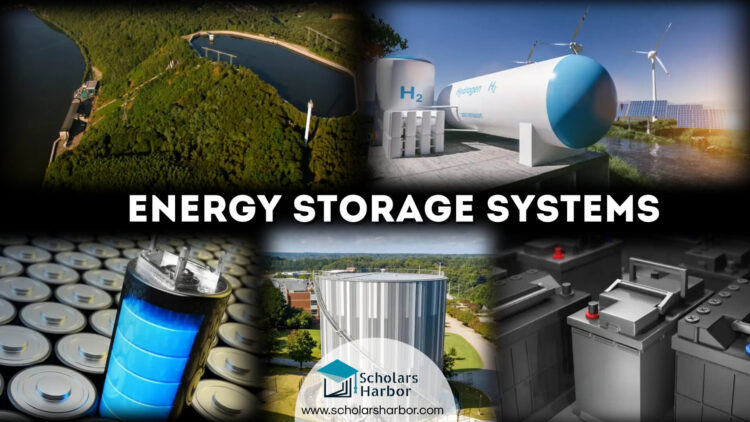Energy storage that can store energy & release it as needed in the form of thermal, electrical, chemical, kinetic, or potential. Energy storage is essential for gathering energy from a variety of sources and transforming it into the forms needed for applications. Since energy storage systems have been in operation for so long, they have undergone constant development, and many of them are now at a mature stage.
The use of energy storage systems frequently has significant advantages, including:
- Equipment size reduction.
- Effective and efficient use of equipment.
- Reduced pollutant emissions (like CO2 and CFCs)
- Fossil fuel Conservation (by enabling more effective energy use and/or fuel substitution).
Types of Energy Storage
Energy storage can be divided into
- Mechanical storage
- Electrochemical storage
- Chemical storage
- Battery storage
- Thermal storage
1. Mechanical Energy Storage
Energy can be stored using mechanical energy storage device and by converted it into mechanical & electrical energies. During off-peak hours or periods of low demand of energy, electricity is transformed to mechanical energy.
On peak demand, mechanical energy is converted into electrical energy. Because this stored energy may be easily transformed into mechanical and electrical energy, these types of storage devices provide a benefit.
Typical mechanical energy storage devices include the following
- Flywheel storage
- Gravity energy storage
- Pumped hydro storage
- Compressed air storage
2. Electrochemical Storage
Capacitors and super capacitors are examples of electrochemical storage. Due to its comparatively low capacitance output, capacitors are only employed for brief durations when high currents are required. Super capacitors are thus being utilized to replace capacitors, but only if they provide extremely high capacitance small packs.
Systems for storing superconducting magnetic energy are typically utilized in power plants or industrial sites to stabilize output. They can also be applied to handle energy consumption peaks
3. Chemical Storage
Hydrogen and Biofuels fall under the category of chemical energy storage systems. The use of hydrogen storage systems falls into 4 categories: liquefaction of hydrogen, hydrogen adsorption on carbon nano-fibers, pressurization of hydrogen and absorption of hydrogen by metal hydrides.
In a steel tank hydrogen can be held at a pressure of 200 to 250 bars. However, because storage efficiency depends on the pressure rise, this is only possible at low ratios of stored hydrogen per unit weight. Today, biological processes are used for a power generation as well as energy storage.
Biomass generation begins with plant and animal waste. The biodegradable portion of energy crops, as well as animal and plant waste, are sources of biomass. From biomass, it is possible to produce biogas for domestic use. Using a generator, electricity can also be generated from biomass
4. Battery Storage
This application has seen one of the most widely utilized energy storage technologies today. Battery storage uses a number of cells connected in series or parallel to produce the desired output. Two conductor electrodes, an electrolyte, and a sealed container make up Battery storage cells, which are then connected to an external load.
Chemical reactions include the exchange of electrons between 2 electrodes, and each electron travels through an external electrical circuit or load. To ensure a constant power source, the batteries are frequently coupled in parallel & series.
Batteries, control and power conditioning systems, along with a plant that guarantees the system’s safe operation, are frequently found in battery energy storage systems. The following are various battery energy storage device types:
- Nickel cadmium battery
- Sodium Sulphur batteries
- Lithium ion battery
- Lead acid batteries
5. Thermal Storage
By using various parameters, including temperature, position, and power, thermal energy heat storage applications are used to store heat or cold. They are typically used for space heating or cooling, producing electricity in a variety of industrial and residential facilities, producing water with variable temperatures.
According to published data, the installed thermal storage capacity is close to 3.3 GW, or close to 2% of the global energy storage. A thermal energy storage system typically consists of a medium of heat-transfer, storage tank, & a container control system.
With the help of unique technology, the stored heat is maintained in the reservoir that is insulated. The heat engine cycle is used to convert heat energy that has been stored originally into electricity. Although the efficiency of thermal storage is moderate (30–50%), This useful technique has a number of noteworthy benefits, including its high energy storage & consistently low self-discharge.
Thermal storage are environmentally beneficial, and launching the project requires only a small capital investment. They are therefore appropriate for massive energy storage systems. Based on mechanical assistance for heat transfer, thermal storage can be divided into
- Active storage
- Passive storage
Conclusion
Energy storage had a great deal of potential because it could boost the system’s efficiency. The technology is much more valuable than creating a new power plant since it can be used to store surplus power & utilize it during times of peak demand. The lack of co2 emission & opportunity for integration with sustainable power would increase the technology’s marketability. Yet, additional investigation & development are needed because no single energy energy storage possesses all of the perfect qualities needed for the best grid integration.
Cite this Article
| Author: | Scholars Harbor |
| Year: | 2022 |
| Title | Advanced Energy Storage Systems And Its Types – Explained |
| Publisher: | Scholars Harbor |
| URL: | https://scholarsharbor.com/advanced-energy-storage-systems-and-its-types-explained/ |













Discussion about this post